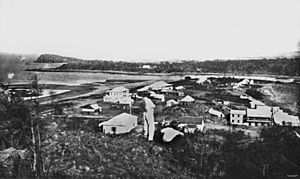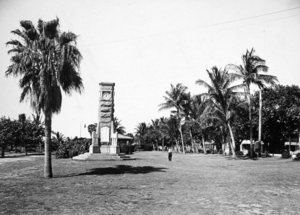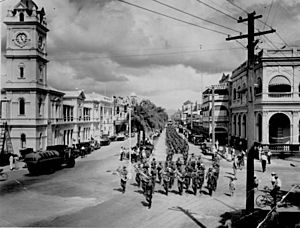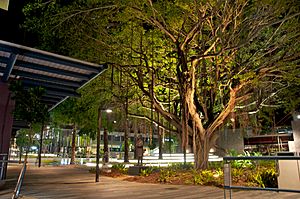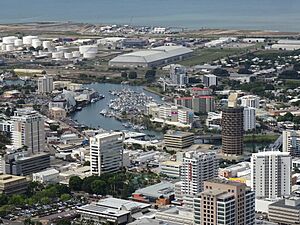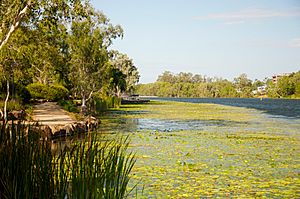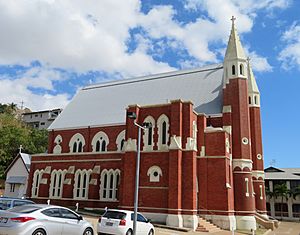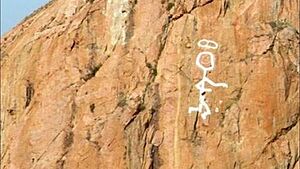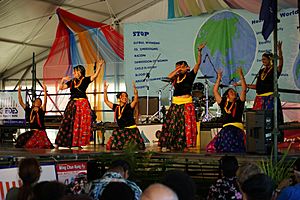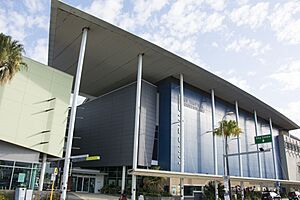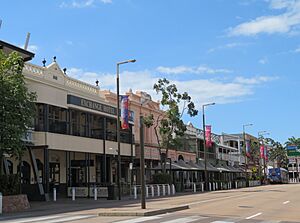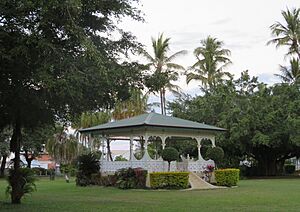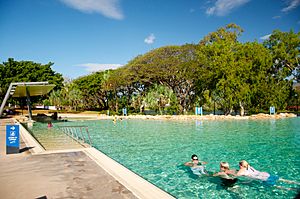Townsville facts for kids
Quick facts for kids TownsvilleQueensland |
|||||||||
|---|---|---|---|---|---|---|---|---|---|
|
Port of Townsville and Marina
Former Queen's Hotel on The Strand
Townsville waterfront with North Queensland Stadium in the background
|
|||||||||
| Population | 201,313 (As of 2024) | ||||||||
| • Density | 290.369/km2 (752.05/sq mi) | ||||||||
| Established | 1865 | ||||||||
| Postcode(s) | 4810 | ||||||||
| Elevation | 15 m (49 ft) | ||||||||
| Area | 693.3 km2 (267.7 sq mi)(2021 urban) | ||||||||
| Time zone | AEST (UTC+10) | ||||||||
| Location |
|
||||||||
| LGA(s) | City of Townsville | ||||||||
| County | Elphinstone | ||||||||
| State electorate(s) |
|
||||||||
| Federal Division(s) | |||||||||
|
|||||||||
Townsville is a city on the north-eastern coast of Queensland, Australia. With a population of 201,313 as of 2024, it is the largest settlement in North Queensland and Northern Australia (specifically, the parts of Australia north of the Sunshine Coast). It is unofficially considered the capital of North Queensland. Townsville hosts a significant number of governmental, community and major business administrative offices for the northern half of the state.
Part of the larger local government area of the City of Townsville, it is in the dry tropics region of Queensland. The city is adjacent to the central section of the Great Barrier Reef. The city is also a major industrial centre, home to one of the world's largest zinc refineries, a nickel refinery and many other similar activities. As of December 2020, $30M operations to expand the Port of Townsville are underway, which involve channel widening and installation of a 70-tonne Liebherr Super Post Panamax Ship-to-Shore crane to allow much larger cargo and passenger ships to utilise the port. It is an increasingly important port due to its proximity to Asia and major trading partners such as China.
Dominant sectors of its diverse economy include defence, administration, health and education, manufacturing, energy, transport and logistics. The city is a national hub for renewable energy, in green hydrogen and polysilicon, as well as the centre of CopperString 2032 being Australia's largest renewable transmission project. Townsville is Australia's 'fortress city', home to a large part of the strategic capability of the ADF, offering essential services including maintenance and supply chains including one of the largest military bases in Australia as well as a Royal Australian Air Force (RAAF) base that can accommodate most military aircraft in service. Townsville is the industrial heart of northern Australia with a GRP of $15.1 billion in 2023. The city is served by Townsville Airport and the Port of Townsville, the largest general freight and container port in northern Australia.
Popular attractions include "The Strand", a long tropical beach and garden strip; Riverway, a riverfront parkland attraction located on the banks of Ross River; Reef HQ, a large tropical aquarium holding many of the Great Barrier Reef's native flora and fauna; the Museum of Tropical Queensland, built around a display of relics from the sunken British warship HMS Pandora; Castle Hill or as it was originally known Cootharinga, the most prominent landmark of the area and a popular place for exercise; The Townsville Sports Reserve; and Magnetic Island, a large neighbouring island, the vast majority of which is national park.
Contents
History
Early history
Such indigenous groups as the Wulgurukaba, Bindal, Girrugubba, Warakamai and Nawagi, among others, originally inhabited the Townsville area. The Wulgurukaba claim to be the traditional owner of the Townsville city area; the Bindal had a claim struck out by the Federal Court of Australia in 2005.
James Cook visited the Townsville region on his first voyage to Australia in 1770, but did not actually land there. Cook named nearby Cape Cleveland, Cleveland Bay and Magnetic(al) Island. In 1819, Captain Phillip Parker King and botanist Alan Cunningham were the first Europeans to record a local landing. In 1846, James Morrill was shipwrecked from the Peruvian, living in the Townsville area among the Bindal people for 17 years before being found by white men and returned to Brisbane.
Establishment
The Burdekin River's seasonal flooding made the establishment of a seaport north of the river essential to the nascent inland cattle industry. John Melton Black of Woodstock Station, an employee of Sydney entrepreneur and businessman Robert Towns, dispatched Andrew Ball, Mark Watt Reid and a small party of aborigines to search for a suitable site. Ball's party reached the Ross Creek in April 1864 and established a camp below the rocky spur of Melton Hill, near the present Customs House on The Strand. The first party of settlers, led by W. A. Ross, arrived at Cleveland Bay from Woodstock Station on 5 November of that year. In 1866 Robert Towns visited for three days, his first and only visit. He agreed to provide ongoing financial assistance to the new settlement and Townsville was named in his honour.
Townsville was declared a municipality in February 1866, with John Melton Black elected as its first Mayor. Townsville developed rapidly as the major port and service centre for the Cape River, Gilbert, Ravenswood, Etheridge and Charters Towers goldfields. Regional pastoral and sugar industries also expanded and flourished. Townsville's population was 4,000 people in 1882 and grew to 13,000 by 1891.
In 1901 Lord Hopetoun made a goodwill tour of northern Australia and accepted an invitation to officially open Townsville's town hall, occasioning the first ever vice-regal ceremonial unfurling of the Australian national flag. With Brisbane, in 1902 Townsville was proclaimed a City under the Local Authorities Act.
The foundation stone of the Townsville Cenotaph was laid in Strand Park on 19 July 1923. It was unveiled on 25 April 1924 (ANZAC Day) by the Queensland Governor, Sir Matthew Nathan.
Townsville/Thuringowa
The rural land surrounding the city was initially managed by the Thuringowa Road Board, which eventually became the Shire of Thuringowa. The shire ceded land several times to support Townsville's expansion. In 1986 the Shire became incorporated as a city, governed by the Thuringowa City Council. The cities of Townsville and Thuringowa were amalgamated into the "new" Townsville City Council in March 2008, as part of the Queensland state government's reform program.
Japanese influence
In 1896, Japan established its first Australian consulate in Townsville, primarily to serve some 4,000 Japanese workers who migrated to work in the sugar cane, turtle, trochus, beche de mer and pearling industries. With the introduction of the White Australia policy, the demand for Japanese workers decreased, causing the consulate to finally close in 1908.
World War II
During World War II, the city was host to more than 50,000
Some of the units based in Townsville were:
- No. 3 Fighter Sector RAAF, Wulguru & North Ward
- 1 Wireless Unit, Pimlico & Stuart & Roseneath
- North Eastern Area Command HQ, Townsville, Sturt Street (now the Federation building)
- Castle Hill, Townsville underground tunnels & bunkers
- Green St. Bunker, West End, Sidney Street West End, Project 81 (now the SES building)
- 96th Engineer Battalion (which mutinied in April 1942.)
In July 1942, three small Japanese air raids were conducted against Townsville, which was by then the most important air base in Australia. Several 500-pound (230-kilogram) bombs were dropped in the harbour, near the Garbutt airfield and at Oonoonba, where bomb craters are still clearly visible. No lives were lost and structural damage was minimal, as the Japanese missed their intended target of the railway and destroyed a palm tree. Although the Japanese aircraft were intercepted on two of the three raids, no Japanese planes were shot down.
1970 onwards
On Christmas Eve 1971, Tropical Cyclone Althea, a category 4 cyclone, battered the city and Magnetic Island, causing considerable damage.
Two very significant hotels on Flinders Street were lost. Buchanan's Hotel was regarded by architectural historians as Australia's most significant building in the Filigree style was lost to fire in 1982 and the Alexandra Hotel to demolition in the 1970s.
Eddie Mabo, who later became famous for his involvement in overturning the legal fiction of terra nullius, worked as a gardener at James Cook University in the 1970s and 1980s. It was here he first learned of the implications of the terra nullius doctrine and decided to take on the Australian government. The James Cook University Douglas campus library is now named after him.
In October 2000, a Solomon Islands Peace Agreement was negotiated in Townsville.
Urban layout
Inner-city high-density development has also created population growth and gentrification of the central business district (CBD). One significant contributor to CBD development was the construction of a new rail passenger terminal and re-siting of the railway workshops, releasing prime real estate which formerly belonged to Queensland Rail for the development of residential units, retail projects and a new performing arts centre. The skyline of Townsville's central business district has undergone dramatic changes over the last few years, with a number of new highrise buildings, both commercial and residential, constructed.
In the short term, much of the urban expansion will continue to the west and the north, in the former City of Thuringowa. The most significant of these is North Shore Estate, a new A$1 billion 5,000-lot housing estate, located close to the Bruce Highway, just north of the Bohle River.
Medium-term city expansion will be focused on two major urban developments that have started in 2017 and 2018. Elliot Springs, a satellite city to the south of Townsville developed by national developer Lendlease Group, is expected to be home to 26,000 people by 2057. Additionally, the Queensland Government announced it will be offering 270 hectares (670 acres) of state-owned land (the former abattoir reserve), just south of the Bohle River, for urban expansion.
Geography
Townsville lies approximately 1,350 kilometres (840 mi) north of Brisbane, and 350 kilometres (220 mi) south of Cairns. It lies on the shores of Cleveland Bay, protected to some degree from the predominantly south-east weather. Cleveland Bay is mostly shallow inshore, with several large beaches and continually shifting sand bars. Magnetic Island lies 8 kilometres (5.0 mi) offshore, to the north of the city centre.
The Ross River flows through the city. Three weirs, fish stocking and dredging of the river in these reaches has resulted in a deep, stable and clean waterway used for many recreational activities such as waterskiing, fishing and rowing. Thirty kilometres from the mouth (at the junction of Five Head Creek) is the Ross River Dam, the major water storage for the urban areas.
The historic waterfront on Ross Creek, site of the original wharves and port facilities, has some old buildings mixed with the later modern skyline. However, the central city is dominated by the mass of red granite called Castle Hill, 292 metres (958 ft) high and just 8 metres short of being a mountain. There is a lookout at the summit giving panoramic views of the city and its suburbs, including Cleveland Bay and Magnetic Island. There are a number of parks scattered throughout the city, including three botanical gardens — Anderson Park, Queens Gardens and The Palmetum.
Climate
Townsville is characterised as a tropical savanna climate (Köppen climate classification Aw). Owing to a quirk of its geographical location, Townsville's winter rainfall in particular is not as high as elsewhere in the coastal tropics of Queensland, such as Cairns. The winter months are dominated by southeast trade winds and mostly fine weather. Further north the coastline runs north/south and the trade winds are lifted to produce rainfall right through the year. Townsville, however, lies on a section of coastline that turns east/west, so the lifting effect is not present. As a result, winter months are dominated by blue skies, warm days and cool nights, although at times significant rainfall may occur.
The average annual rainfall is 1,143 millimetres (45.0 in) on an average 91 rain days, most of which falls during the six-month "wet season" from November to April. Because of the "hit or miss" nature of tropical lows and thunderstorms, there is considerable variation from year to year. Annual rainfall has ranged from 397.6 millimetres (15.65 in) in 2015 to 2,399.8 millimetres (94.48 in) in 2000. Rainfall also varies considerably within the metropolitan area; it typically ranges from 1,136 millimetres (44.7 in) at central Townsville City to 853 millimetres (33.6 in) at Woodstock, a southwestern suburb. The wettest 24 hours on record was 11 January 1998, with 548.8 millimetres (21.61 in) falling mostly in a 12-hour period after dark, which has since been dubbed the "Night of Noah" by Townsville residents.
| Climate data for Townsville Airport, Australia | |||||||||||||
|---|---|---|---|---|---|---|---|---|---|---|---|---|---|
| Month | Jan | Feb | Mar | Apr | May | Jun | Jul | Aug | Sep | Oct | Nov | Dec | Year |
| Record high °C (°F) | 44.3 (111.7) |
42.7 (108.9) |
37.6 (99.7) |
35.8 (96.4) |
32.2 (90.0) |
32.2 (90.0) |
31.6 (88.9) |
33.3 (91.9) |
36.5 (97.7) |
37.1 (98.8) |
41.0 (105.8) |
42.1 (107.8) |
44.3 (111.7) |
| Mean daily maximum °C (°F) | 31.4 (88.5) |
31.1 (88.0) |
30.7 (87.3) |
29.7 (85.5) |
27.7 (81.9) |
25.6 (78.1) |
25.1 (77.2) |
26.1 (79.0) |
27.8 (82.0) |
29.5 (85.1) |
30.8 (87.4) |
31.5 (88.7) |
28.9 (84.0) |
| Mean daily minimum °C (°F) | 24.3 (75.7) |
24.1 (75.4) |
23.0 (73.4) |
20.6 (69.1) |
17.7 (63.9) |
14.7 (58.5) |
13.7 (56.7) |
14.7 (58.5) |
17.4 (63.3) |
20.7 (69.3) |
22.9 (73.2) |
24.1 (75.4) |
19.8 (67.6) |
| Record low °C (°F) | 18.7 (65.7) |
17.9 (64.2) |
16.7 (62.1) |
10.9 (51.6) |
6.2 (43.2) |
4.4 (39.9) |
3.5 (38.3) |
1.1 (34.0) |
7.7 (45.9) |
8.2 (46.8) |
14.1 (57.4) |
17.9 (64.2) |
1.1 (34.0) |
| Average precipitation mm (inches) | 270.1 (10.63) |
298.7 (11.76) |
192.4 (7.57) |
66.4 (2.61) |
31.7 (1.25) |
21.2 (0.83) |
14.9 (0.59) |
16.1 (0.63) |
10.4 (0.41) |
23.4 (0.92) |
58.4 (2.30) |
127.7 (5.03) |
1,134.7 (44.67) |
| Average precipitation days | 14.5 | 15.5 | 12.6 | 7.7 | 5.8 | 4.2 | 3.0 | 2.6 | 2.4 | 4.7 | 7.3 | 9.8 | 90.1 |
| Average afternoon relative humidity (%) | 65 | 67 | 63 | 60 | 56 | 52 | 51 | 52 | 53 | 55 | 58 | 60 | 58 |
| Mean monthly sunshine hours | 244.9 | 204.4 | 235.6 | 234.0 | 232.5 | 234.0 | 263.5 | 279.0 | 288.0 | 303.8 | 282.0 | 279.0 | 3,080.7 |
| Source: Bureau of Meteorology | |||||||||||||
| Townsville Rainfall Data mm (inches) | |||||||||||||||
|---|---|---|---|---|---|---|---|---|---|---|---|---|---|---|---|
| Month | Jan | Feb | Mar | Apr | May | Jun | Jul | Aug | Sep | Oct | Nov | Dec | Total | ||
| Highest rainfall | 1,141.7 (44.9) | 960.8 (37.8) | 696.2 (27.4) | 546.2 (21.5) | 180.8 (7.1) | 111.4 (4.4) | 173.7 (6.8) | 258.2 (10.2) | 84.4 (3.3) | 252.8 (10.0) | 345.2 (13.6) | 458.0 (18.0) | 2,399.8 (94.5) | ||
| Highest 24-hour rainfall | 548.8 (21.6) | 317.6 (12.5) | 366.5 (14.4) | 271.6 (10.7) | 96.0 (3.8) | 93.0 (3.7) | 89.8 (3.5) | 134.2 (5.3) | 64.6 (2.5) | 89.4 (3.5) | 132.8 (5.2) | 206.8 (8.1) | 548.8 (21.6) | ||
| Average rainfall | 270.1 (10.6) | 298.7 (11.8) | 192.4 (7.6) | 66.4 (2.6) | 31.7 (1.2) | 21.2 (0.8) | 14.9 (0.6) | 16.1 (0.6) | 10.4 (0.4) | 23.4 (0.9) | 58.4 (2.3) | 127.7 (5.0) | 1,134.7 (44.7) | ||
| Lowest rainfall | 8.8 (0.3) | 4.2 (0.2) | 2.0 (0.1) | 0.3 (0.0) | 0.0 (0.0) | 0.0 (0.0) | 0.0 (0.0) | 0.0 (0.0) | 0.0 (0.0) | 0.0 (0.0) | 0.2 (0.0) | 0.0 (0.0) | 397.6 (15.7) | ||
| Bureau of Meteorology | |||||||||||||||
December is the warmest month of the year with daily mean maximum and minimum temperatures being 31.5 °C (88.7 °F) and 24.1 °C (75.4 °F) respectively. July is the coolest month with daily mean maximum and minimum temperatures being 25.1 °C (77.2 °F) and 13.7 °C (56.7 °F). Townsville experiences an annual mean of 8.5 hours of sunshine per day, averaging 120.8 clear days per year.
Tropical cyclones
Like most of North Queensland, Townsville is susceptible to tropical cyclones. They usually occur between December and April, forming mainly out in the Coral Sea, and usually tracking west to the coast. Notable cyclones to affect the Townsville Region have been: Cyclone Yasi (2011), Cyclone Tessi (2000), Cyclone Sid (1998, in particular damaging The Strand), Cyclone Joy (1990), Cyclone Althea (1971), Cyclone Leonta (1903) and Cyclone Sigma (1896).
Townsville and Thuringowa experienced major flooding in January 1998 due to Cyclone Sid.
Governance
Townsville has offices of many State and Federal Government agencies, such as Centrelink and the Australian Taxation Office.
Local
Townsville is governed by a City Council, comprising an independently elected Mayor and 10 Councillors who each represent a separate division within the local government area. Following local government reform undertaken by the Government of Queensland prior to the March 2008 elections, the previous entities of NQ Water, The City of Townsville and the City of Thuringowa were amalgamated.
In the 2024 Townsville City Council election, Troy Thompson (Independent), was sworn in as Mayor of Townsville. The previous Mayor of Townsville was Jenny Hill, a member of the Labor Party. Hill was elected in April 2012, replacing the retiring Les Tyrell and defeating main opposing candidate Dale Last. Tyrell was the immediate past Mayor for 17 years of the former local government authority, the City of Thuringowa. The previous Mayor of Townsville for 19 years was Tony Mooney (Australian Labor Party). Hill faced a largely hostile chamber in her first term, with 'Townsville First' candidates winning the majority of divisions. When local government elections were held in March 2016, Jenny Hill was re-elected as Mayor of Townsville. She was re-elected in the 2020 Queensland local government elections.
State
In the unicameral Queensland Parliament five electorates cover the Townsville Region:
- Electoral district of Burdekin (southern suburbs): Dale Last MP (Liberal National Party of Queensland)
- Electoral district of Hinchinbrook (northern suburbs): Nick Dametto MP (Katter's Australian Party)
- Electoral district of Mundingburra (central/southern suburbs): Les Walker MP (Australian Labor Party)
- Electoral district of Thuringowa (western/northern suburbs): Aaron Harper MP (Australian Labor Party)
- Electoral district of Townsville (CBD + Magnetic & Palm Islands): Scott Stewart MP (Australian Labor Party)
Federal
The majority of the population of Townsville is represented in the Australian House of Representatives by Phillip Thompson of the Liberal National Party, reelected as the member for the Division of Herbert at the 2022 Australian federal election. Some of the suburbs on the southern fringe of the urban area are part of the Division of Dawson and are represented by Andrew Willcox, representing the Liberal National Party. Some of the northern suburbs of Townsville, known collectively as the "Northern Beaches", are included in the Division of Kennedy which is represented by Bob Katter (Katter's Australian Party), who is based in Mount Isa about 900 kilometres (560 mi) west of Townsville.
Economy
The city has a diverse economy with strengths in education, healthcare, retail, construction and manufacturing. It is a defence hub and is home to thousands of military personnel. It is also a major manufacturing and processing hub. Townsville is the only city globally to refine three different base metals — zinc, copper, and nickel — and it is planned in the near future to be home to a $2billion lithium-ion battery manufacturing facility developed by the Imperium3 consortium in partnership with Siemens. Nickel ore is imported from Indonesia, the Philippines and New Caledonia and processed at the Yabulu Nickel refinery, 30 kilometres (19 mi) north of the port. Zinc ore is transported by rail from the Cannington Mine, south of Cloncurry, for smelting at the Sun Metals refinery south of Townsville. Copper concentrate from the smelter at Mount Isa is also railed to Townsville for further refining at the copper refinery at Stuart.. The zinc refinery is one of the world's largest with an expansion from 2019.
Townsville has several large public assets as a result of its relative position and population. These include the largest campus of the oldest university in northern Queensland, James Cook University, the Australian Institute of Marine Science headquarters, Great Barrier Reef Marine Park Authority, the large Army base at Lavarack Barracks, and RAAF Base Townsville.
Demographics
Townsville's population was 179,011 at the 2021 census. The city has a younger population than the Australian and Queensland averages. The city has traditionally experienced a high turnover of people, with the army base and government services bringing in many short to medium term workers. The region has also become popular with mine workers on fly in/fly out contracts.
In 2021, 9.0% of Townsville's population was of Aboriginal or Torres Strait islander descent. In 2021, there were 21,180 people of Aboriginal or Torres Strait islander descent living in Townsville.
Education
There are over 60 private and state schools of primary and secondary education within the Townsville area. Townsville Grammar School is the oldest co-educational school on the Australian mainland. The Townsville State High School opened on 7 June 1924 and The Cathedral School of St Anne & St James opened in 1917.
Universities
James Cook University (JCU) is a public university based in Townsville. Established in 1970, the main campus is located in the suburb of Douglas. JCU was the second university in Queensland and the first in North Queensland. The University has a strong and internationally recognised expertise in marine & tropical biology. The JCU Medical School was established in 1999 and is linked with the adjacent tertiary-level Townsville Hospital. The Veterinary Sciences undergraduate facility is the newest in Australia.
CQUniversity first established a presence in Townsville in 2014 with the opening of a Distance Education Study Centre in the CBD. The University quickly felt the demand for a face-to-face teaching presence in Townsville and has since opened a purpose built campus in the city offering many on-campus courses including nursing, paramedic science, business and psychology as well as supporting growing numbers of online students.
Vocational education
The city is home to the Pimlico and Aitkenvale campuses of TAFE Queensland North — a Technical and Further Education College, a campus of Queensland Agricultural Training Colleges, and Tec-NQ.
Culture, events and festivals
The city is home to the Townsville Saint, a 6 m (20 ft) stick figure depicting The Saint on the northern cliff face of Castle Hill, painted by seven first-year University College of Townsville (which would later become James Cook University) students on St Patrick’s Day, 17 March 1962. The figure went on to survive numerous attempts at removal. On 28 May 1993, The Saint became integrated with the heritage significance of the hill as a natural and cultural landmark. In 2013, the Townsville City Council won legal ownership of The Saint as a trademark, protecting its use by the wider community. The mystery of who painted the figure was revealed on the 40th anniversary (2002) to be Graeme Bowen, Lyall Ford, Rodney Froyland, David Greve, Peter Higgins, Barrie Snarski and Robert Sothman. While adopted by the University from the beginning, The Saint has become iconic, surviving opposition and attempts at removal.
The Australian Festival of Chamber Music is an international chamber music festival held over ten days each July in Townsville. The festival has been running since 1991, and attracts many acclaimed international and Australian musicians. Townsville also has its own orchestra, the Barrier Reef Orchestra, which presents concerts throughout North Queensland. The Townsville Entertainment Centre, seating more than 5,000 people, is host to many national and international music shows, as well as sporting and trade shows.
The region has many renowned festivals, many which celebrate the international heritage of many that call North Queensland home. The Annual Greek, Italian and Indian Festivals are popular with the locals and tourists alike. The Stable on the Strand is celebrated each Christmas.
The Townsville Civic Theatre is North Queensland's premier cultural facility. Since its opening in 1978, the Theatre has been a centre of entertainment and performing arts, providing an environment to further develop the performing arts in Townsville and the North. TheatreiNQ is an independent professional theatre company based in Townsville, presenting four shows a year including the popular annual Shakespeare Under the Stars in Queen Gardens. Dancenorth Australia is a contemporary dance company based in Townsville, whose works tour all over Australia and the World. Dancenorth is the only performing arts organisation based in regional Queensland to be included in the Australian Government's National Performing Arts Partnership Framework.
The Perc Tucker Regional Gallery is the public art gallery of Townsville. Located on the eastern end of Flinders Mall, the Gallery focuses on artwork relevant to North Queensland and the Tropics. Every second September the gallery presents sculpture artworks and art festival called Strand Ephemera, exhibited over the two kilometre beachfront strip. The City is also home to Umbrella Studios who regularly exhibit and promote the work of artists from the region.
The Townsville City Council and Townsville Intercultural Centre annually organises Cultural Fest in mid August. The festival has been held in various locations across the city over its history, and is currently held on the grounds of James Cook University. The Cultural Fest showcases the cultural diversity of the city and dance, food, and music from different ethnic groups in the region.
The city has several museums. The Maritime Museum of Townsville, also known as the Townsville Maritime Museum, is located as part of the Port of Townsville. Its features include HMAS Townsville, SS Yongala, and lenses from current and former lighthouses. The Museum of Tropical Queensland (abbreviated MTQ) is a museum of natural history, archaeology and history. In addition to housing artifacts from the wrecks, the museum administers the shipwreck sites for HMS Pandora and SS Yongala. The Museum of Underwater Art (MOUA) features the work of underwater sculptor Jason deCaires Taylor, including the coral greenhouse at John Brewer Reef and the ocean siren at The Strand.
The city has many restaurants, concentrated on Palmer Street in South Townsville, Flinders Street and along the Strand. The city also has a vibrant pub and night-club scene, many of them located in Flinders Street East.
Architecture
There are many well-preserved old buildings in Townsville dating from the 19th and the beginning of the 20th centuries, especially in Flinders Street which is the oldest street. One of the most famous buildings is the Townsville Post Office, built in 1886 with a clock tower which was dismantled in 1942 and reconstructed in 1963/64. Another sightworthy building is the Australian Joint Stock Bank which was built 1887–88. Tattersalls Hotel which was built as early as 1864, the former Bank of New South Wales dating from 1887 and the former Bank of Australasia built in 1905 are sightworthy historic buildings as well. The Australian Joint Stock Bank (1887–88), the Townsville Technical College dating from 1920/21, the Westpac Bank Building (1935) and the Great Northern Hotel with its large balconies which was completed in 1901 are worth a visit as well. The former Main Train Station opposite the Great Northern Hotel was built 1910–1913 and inaugurated on 24 December 1913.
One of the most impressive churches of Townsville is Sacred Heart Roman Catholic Cathedral which was built 1896–1902. St. James' Anglican Cathedral was built in two stages 1887–1892 and 1959–1960.
Parks
Queens Gardens, laid out in 1870 in the Northern part of Townsville cover an area of 4 ha (9.9 acres). Originally they were a part of a botanical garden of 100 acres (40 ha) dedicated to the experimentation and propagation of tropical plants like breadfruit, mahogany, coffee and mangoes.
The Strand is considered the most popular park of Townsville. In 1950, Tobruk Memorial Baths were inaugurated here. The Strand is known for its Rock Pool and for various cultural events which take place here.
Anderson Park covering an area of about 20 ha in the district of Muningburra is mainly known for its ferns and pandanus. The park is named after William Andersen (1845–1935), the first curator of parks of the city. The park was laid out in 1929. Its design was prepared in 1962 by Allan Wilson, Superintendent of parks from 1959 to 1969.
Townsville Palmetum, a park covering an area of 17 ha with about 300 species of plants, was inaugurated in the South of Townsville in 1988. Most of the 60 species of palms which are native to Australia can be seen here.
The first park in the city centre which was named Anzac Memorial Park later was laid out as early as 1912. A bandstand was built in the middle of the park in 1913.
Media and communications
Townsville is the media centre for North Queensland, with four commercial and five narrowcast radio stations, North Queensland ABC radio station, three commercial television stations, one regional daily newspaper and one community weekly newspaper (both owned by News Ltd). There are no local Sunday papers although The Sunday Mail (Qld) — based in Brisbane — does have a North Queensland edition. Media distributed on the World Wide Web include the Townsville Bulletin.
Sport and recreation
Townsville hosts several sporting teams that participate in national competitions. These include the North Queensland Cowboys (National Rugby League), who play at Queensland Country Bank Stadium and the Townsville Fire (Women's National Basketball League) who play at the Townsville RSL Stadium. The city also formerly hosted the Townsville Crocodiles, (National Basketball League) who played out of the Townsville Entertainment Centre, known as The Swamp during Crocs home games.
Queensland Country Bank Stadium is the home ground for the Cowboys. It replaced the Willows Sports Complex. The Willows Sports Complex was an official venue for the 2003 Rugby Union World Cup, with three matches played in Townsville. Townsville hosted the popular Japanese national rugby union team. Tony Ireland Stadium, in the suburb of Thuringowa, has an international standard cricket and AFL stadium. Townsville was a host city for the preliminary rounds of the men's (Pool B) and women's (pool A) Basketball competition for the 2018 Gold Coast Commonwealth Games.
The most popular sport in Townsville is rugby league. In addition to the Cowboys in the NRL, Townsville and its surrounding suburbs host a number of local junior and senior rugby league sides in the successful Townsville District Rugby League, including A-grade sides: Brothers Townsville, Norths Devils, Souths, Western Lions and Centrals ASA Tigers. The local league has produced a number of Australian internationals such as Gorden Tallis and Gene Miles.
Townsville also hosts two Touch Football associations. The Townsville/Castle Hill Touch Association (TCHTA) conducts competitions annually at its grounds at Queens Park, Townsville. Thuringowa Touch Association (TTA) also conducts competitions at Greenwood Park, Kirwan. Both competitions have produced a host of regional, state and national representative players and officials.
Townsville is also home to Football Queensland North. Soccer is played by junior participants in the city. Major clubs include MA Olympic, Brothers Townsville, and Saints Eagles Souths FC. As of 2020, soccer had 3,614 participants in the region.
Townsville and Districts Rugby Union run a successful Winter Junior and Senior Rugby Union competition including teams from Ingham, Charters Towers and Ayr. Townsville has produced a number of members of the Australia national rugby union team (the Wallabies) in the past including Peter Grigg and Sam Scott-Young.
AFL Townsville operate a regional Australian rules football league in the region. Jake Spencer is the first local player to play in the AFL.
Several Australian Test and ODI cricketers have come out of Townsville including fast bowler Mitchell Johnson, Andrew Symonds and James Hopes. In 2012 Townsville hosted under 19 cricket World Cup preliminary matches, semi finals and the final featuring Australia and India.
The Townsville Running Festival is an annual event organised by the Townsville Road Runners that began with the first Townsville Marathon in 1972 and now also includes several shorter fun runs.
Townsville is hosting the World Triathlon Multisport World Championships from 15 to 25 August 2024.
The Reid Park Street Circuit is located in Reid Park. Each July since 2009, it hosts the Townsville 400 for the Supercars Championship.
Townsville also has a go cart track and motocross track; Townsville had a 1/4-mile dragstrip, but it closed its gates on 25 August 2012 due to urban development.
Rowing occurs at Townsville & JCU Rowing Club and Riverway Rowing Club. Both clubs cater to competitive masters, social, learn to row and school-based rowing programs. In 2009 the Townsville & JCU club won its first Queensland Club Premiership and in 2010 Riverway club claimed theirs.
Townsville has 3 Tennis Clubs. The Western Suburbs Tennis Club Inc., Tennis Townsville Inc. and Kalynda Chase Tennis Centre. Each year Tennis Townsville host the NQ Open Championships and Western Suburbs Tennis Club host the Townsville Open. These tournaments see Australian and international players competing for up to $10,000 prize money and the opportunity to improve their Australian Tennis Ranking.
Townsville Speedway is a speedway venue located at the Townsville Showground on Showgrounds Road, off Ingham Road. It has also been used for motorcycle speedway and has hosted important events, including the Australian qualifying round of the Speedway World Championship in 1990 and the final of the Queensland Solo Championship on four occasions.
Infrastructure
Transport
Townsville is the intersection point of the A1 (Bruce Highway), and the A6 (Flinders Highway) National Highways. The Townsville Ring Road, planned to become part of the re-routed A1 route bypass, circumnavigates the city.
Townsville has a public transport system contracted to Translink, which provides regular services between many parts of the city. Public transport is also available from the CBD to Bushland Beach. Regular ferry and vehicular barge services operate to Magnetic Island and Palm Island.
Construction of railways in the area of Townsville started as early as 1879, and the first railway line was inaugurated in 1880. The line to Mount Isa which is used by The Inlander today was inaugurated in 1929. The railway lines to Cairns and Brisbane which are used by the Spirit of Queensland were inaugurated in 1929 as well. The former train station, a very representative building at the end of Flinders Street, was completed in 1913. The present train station of Townsville was opened in 2003.
The Tilt Train service connects Townsville railway station to Brisbane in the south and Cairns in the north. Townsville is a major destination and generator of rail freight services. The North Coast railway line, operated by Queensland Rail, meets the Western line in the city's south. Container operations are also common and the products of the local nickel and copper refineries, as well as minerals from the western line (Mount Isa), are transported to the port via trains. The Port of Townsville has bulk handling facilities for importing cement, nickel ore and fuel, and for exporting sugar and products from North Queensland's mines. The port has three sugar-storage sheds, with the newest being the largest under-cover storage area in Australia.
The city is served by Townsville International Airport. The Airport handles direct domestic flights to Darwin, Brisbane, Sydney, Melbourne, as well as direct regional flights to destinations such as Cairns, Mackay, Mount Isa, Rockhampton and Toowoomba. Airlines currently servicing the airport include Qantas, Virgin Australia, Jetstar, Regional Express, Qantaslink and Airnorth.
Defence facilities
The Australian Army maintains a very strong presence in the north of Australia and this is evident by the basing of the Army's 3rd Brigade at Lavarack Barracks in Townsville. The 3rd Brigade is a light infantry brigade. The brigade consists of two light infantry battalions — the 1st and 3rd Battalions of the Royal Australian Regiment (1 and 3 RAR) – and a cavalry contingent – the 2nd Cavalry Regiment. It also has integral Artillery, Engineer, Aviation Reconnaissance and Combat Service Support units. It is a high-readiness brigade that has been deployed frequently at very short notice on combat operations outside mainland Australia. These include Somalia, Rwanda, Namibia, East Timor, Bougainville, Solomon Islands, Iraq and Afghanistan.
In addition to the 3rd Brigade, a number of other major units are based in Townsville. These include the 5th Aviation Regiment, equipped with MRH-90 and Chinook helicopters, co-located at the RAAF Base in Garbutt and the 10th Force Support Battalion based at Ross Island. 10 FSB is a force logistics unit that provides back up logistic support to deployed units. The battalion provides specialist transport (including amphibious) and supply support. Along with this there is also the 11th Combat Service Support Battalion and the 3rd Combat Engineer Regiment.
The Army also maintains an Army Reserve brigade in Townsville designated the 11th Brigade. This formation is similar in structure to the 3rd Brigade but comprises reserve soldiers only. There is also two active cadet units, 130 ACU located within Heatley Secondary College and 15 ACU located on Lavarack Barracks as of 2010, previously located at Ignatius Park College.
As with the Army, the Royal Australian Air Force also maintains a presence in Townsville. RAAF Base Townsville, which is located in the suburb of Garbutt, houses the Beech KingAir 350 aircraft from No. 38 Squadron RAAF. This unit operated the venerable DHC-4 Caribou aircraft until late 2009; however, it has re-equipped in the short term while protracted analysis for a more appropriate Battlefield Transport and Utility aircraft continues. This detachment provides support to the Army units in Townsville. The base is also a high readiness Defence asset and is prepared to accept the full range of RAAF aircraft types as well as other international aircraft including the huge C-17 Globemaster III.
Townsville is also the staging point for the movement of personnel and materials to the remote parts of Northern Australia and many overseas locations. The Australian Navy's two Canberra-class landing helicopter dock ships visit Townsville frequently to exercise with the 3rd Brigade and other troops and formations from the area and deploy them when tasked.
Community groups
The Townsville branch of the Queensland Country Women's Association meets at the CWA Hall at 36 Latchford Street, Pimlico.
Sister cities
Townsville's sister cities are:
 Port Moresby, Papua New Guinea
Port Moresby, Papua New Guinea Shūnan, Yamaguchi, Japan
Shūnan, Yamaguchi, Japan Iwaki, Fukushima, Japan
Iwaki, Fukushima, Japan Changshu, Jiangsu, China
Changshu, Jiangsu, China Suwon, Gyeonggi, South Korea
Suwon, Gyeonggi, South Korea Foshan, Guangdong, China
Foshan, Guangdong, China
Notable people
Athletes
- Jarrod Bannister (1984–2018), Australian athlete and Olympian
- Glenn Buchanan (born 1962), Australian Olympic butterfly swimmer
- Lizette Cabrera (born 1997), Australian International Tennis Player
- Tom Chester (born 2001), Australian rugby league player
- Brett Clarke (born 1972), Australian Olympic table tennis player
- Natalie Cook (born 1975), Australian Olympic beach volleyball player
- Mervyn Crossman (1935–2017), Australian Olympic field hockey player
- Daisy D'Arcy (born 2002), Australian rules footballer
- Tony David (born 1967), professional darts champion
- Renita Farrell-Garard (born 1972), Australian hockey player and dual Olympic gold medalist
- Dennis Firestone (born 1944), Australian racing driver
- Helen Gray (born 1956), Australian Olympic swimmer
- Tom Green (born 2001), Australian rules footballer
- Peter Grigg, Australian rugby union player
- Josh Hall (born 1990), Australian rules footballer
- Rob Hammond (born 1981), Australian field hockey player
- Ellie Hampson (born 2001), Australian rules footballer
- Jarrod Harbrow (born 1988), Australian rules footballer
- Lesleigh Harvey (born 1960), Australian Olympic swimmer
- Valentine Holmes (born 1995), Australian Rugby League player
- James Hopes (born 1978), Australian cricketer
- Josh Jenkins (born 1989), Basketballer and Australian rules footballer
- Corey Jensen (born 1994), Australian rugby league player
- Mitchell Johnson (born 1981), Australian cricketer
- Breanna Koenen (born 1994), Australian rules footballer
- Laurie Lawrence (born 1941), Australian Olympic swimming coach
- Summer Lochowicz (born 1978), Australian Olympic beach volleyball player
- James Mason (born 1947), Australian Olympic field hockey player
- Luke McLean (born 1987), Italian Australian Rugby Union footballer
- Gene Miles (born 1959), Australian rugby league footballer
- Jack Miller (born 1995), Australian MotoGP rider
- Danny Moore, (born 1971), Australian rugby league player
- Greg Norman (born 1955), former golf world number one
- Aaron Payne (born 1982), Australian Rugby League player
- Russell Perry (born 1938), Australian Olympic weightlifter
- John-Patrick Smith (born 1989), Australian tennis player
- Braydon Preuss (born 1995), Australian rules footballer
- Sam Scott-Young, Australian rugby union player
- Gehamat Shibasaki (born 1998), Australian rugby league player
- Jamal Shibasaki (born 2005), Australian rugby league player
- Jake Spencer (born 1989), Australian rules footballer
- Andrew Symonds (1975–2022), Australian cricketer, played for the Wanderers club in Townsville
- Gorden Tallis (born 1973), Australian rugby league footballer
- Sam Thaiday (born 1985), State of Origin and Australian rugby league player
- Pud Thurlow (1903–1975), Australian test cricketer in the 1930s
- Johnathan Thurston (born 1983), first North Queensland Cowboys NRL Premiership winning co/Captain with Matthew Scott
- Adrian Trevilyan (born 2001), Australian rugby league player
- Libby Trickett (née Lenton; born 1985), Australian Olympic swimmer
- Breiana Whitehead (born 2000), Australian Olympic kitefoiler
- Zaria, professional wrestler
Journalists
- Julian Assange (born 1971), editor-in-chief of WikiLeaks
- Clem Christesen (1911–2003), journalist and editor of the Australian literary magazine, Meanjin
- Yvonne Sampson (born 1980), Foxtel sports journalist
- John Vause, CNN reporter and anchor
Artists
- Ben Bennett, Australian singer
- Billy Doolan (born 1952), Australian Indigenous artist
Military personnel
- James Cannan (1882–1976), former Australian major general
- Charles Raymond Gurney (1906–1942), Australian aviator
- Air Vice Marshal Ellis Wackett (1901–1984), Australian military aviation pioneer
- Sir Lawrence Wackett (1896–1982), Australian aircraft industry pioneer
Lawyers and politicians
- Bill Heatley (1920–1971), former Liberal senator
- Patricia Staunton (born 1946), Australian magistrate and former NSW politician
- Russell Skerman (1903–1983), Supreme Court judge
Scientists and mathematicians
- Joe Baker (1932–2018), marine scientist and rugby league footballer
- Terry Hughes (born 1956), marine biologist specialising in the study of coral reefs
- Helene Marsh (born 1945), environmental scientist, specialising in the study of dugongs
- Ralph Douglas Kenneth Reye (1912–1977), Australian pathologist who first described Reye's syndrome.
- Peter Ridd, physicist and author
- John Veron (born 1945), specialist in the study of corals and reefs
- Edwin C. Webb (1921–2006), Biochemist, Vice-Chancellor of Macquarie University
- Nicole Webster, marine scientist
- William J. Youden (1900–1971), statistician
Others
- Lyn Ashley (born 1940), actress, daughter of Madge Ryan
- Harriet Dyer (born c. 1988), Hollywood film actress
- Rick Farley (1952–2006), Australian activist for Indigenous Australians’ rights and former CEO of the National Farmers Federation
- Rachael Finch (born 1988), Miss Universe Australia 2009 and 3rd runner-up at Miss Universe 2009
- Madge Ryan (1919–1994), Hollywood, Broadway, and British (Witness in the Dark) stage and film actress – (Vide supra, daughter, Lyn Ashley)
- Francis Stuart (1902–2000), Irish writer
- Natalie Weir (born 1967), Australian choreographer
See also
 In Spanish: Townsville para niños
In Spanish: Townsville para niños









